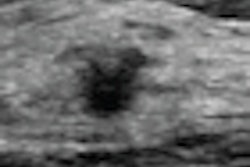Screening mammography guidelines issued by the U.S. Preventive Services Task Force (USPSTF) in 2009 led to a decline in breast screening, which, in the future, may lead to missed cancers, according to research presented last week at the RSNA 2012 meeting.
Routine screening mammography had long been recommended by both the USPSTF and the American Cancer Society for all women older than age 40. But in 2009, the USPSTF issued new guidelines that removed the recommendation for women ages 40 to 49, instead recommending routine screening with mammography every two years for women 50 to 74 years old.
In two studies presented at last week's RSNA conference, researchers analyzed the impact of the guidelines on women between the ages of 40 and 49 in the Medicare population.
Dr. Elizabeth Arleo, of NewYork Presbyterian Hospital/Weill Cornell Medical Center, and colleagues conducted a study that included women screened at the hospital between 2007 and 2010. During that time period, 43,351 screening exams were performed and 205 breast cancers were found, for a cancer detection rate of 4.7 per 1,000 screening mammograms, according to Arleo's group.
Patients screened in their 40s accounted for 33.5% of the population screened and 19% of cancers found. More than 50% (21 of 39) of the screen-detected cancers in women in their 40s were invasive, and only three of the patients in their 40s who were diagnosed with breast cancer found on screening had a first-degree relative with premenopausal breast cancer, the team found.
If the 2009 USPSTF recommendations had been followed during these years, these cancers may not have been detected until the patients' baseline screening mammogram at 50, or until they progressed to clinically evident, palpable disease, according to Arleo's group.
"Nearly 20% of cancers detected with screening mammography were found among women in their 40s," Arleo said in a statement. "[It's] unacceptable to potentially miss nearly 20% of the breast cancers we are identifying. This, in our view, would represent a substantial degree of underdiagnosis."
Guidelines affected screening rates
In a second study, researchers from Thomas Jefferson University found that screening mammography rates declined by 4.3% in 2010, the first full year after the USPSTF's new guidelines were released.
"Prior to the USPSTF recommendation, the screening mammography rate in Medicare female beneficiaries had been growing in small increments each year, with an average annual increase of just under 1%," wrote lead study author Dr. David C. Levin and colleagues. "The USPSTF document appears to have had a noticeable impact on the willingness of women to undergo breast cancer screening."
Levin and his colleagues evaluated how much these recommendations affected the use of screening mammography in the Medicare population. The team used Medicare Part B Physician/Supplier Procedure Summary Master Files for 2005 to 2010, selecting codes for screening mammography (both film and digital) and calculating screening mammography rates per 1,000 Medicare beneficiaries per year.
Levin's group found the following screening mammography rates per 1,000 Medicare female beneficiaries:
Medicare mammography screening rates
|
These years showed a compound annual growth rate (CAGR) of 0.9%. However, in 2010 the rate dropped to 309.1, a decline of 4.3%.
"There was considerable controversy over the task force guidelines, but it was unclear how much they would influence women's choices about screening," Levin said in a statement. "We're not able to tell from the data whether this significant drop in utilization was a result of women deciding to wait another year to have their mammogram, or women over the age of 74 not having the exam. But, clearly, the new USPSTF guidelines have had an effect."




















